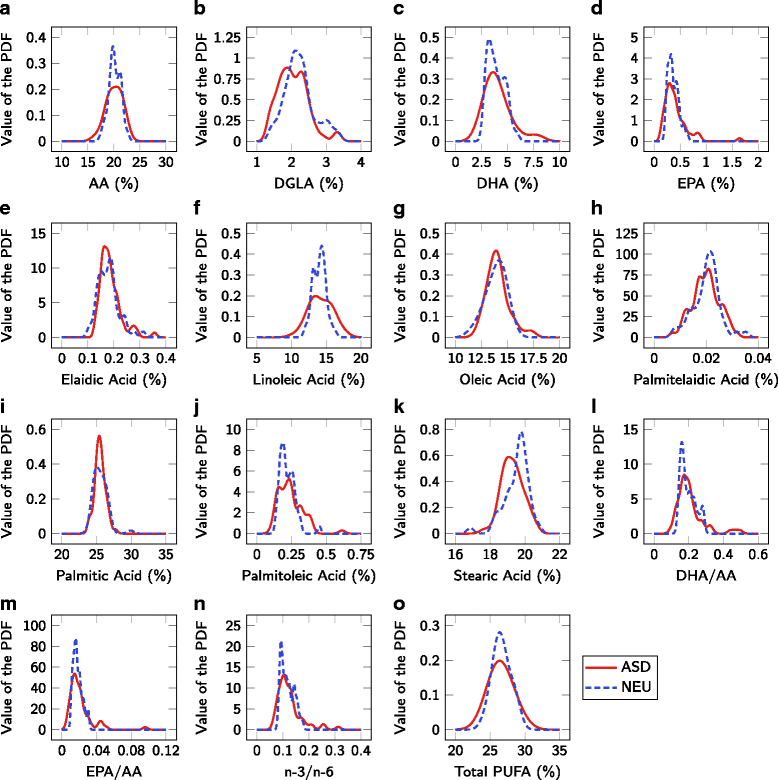Erythrocyte fatty acid profiles in children are not predictive of autism spectrum disorder status: a case control study
- PMID: 29568526
- PMCID: PMC5853097
- DOI: 10.1186/s40364-018-0125-z
Erythrocyte fatty acid profiles in children are not predictive of autism spectrum disorder status: a case control study
Abstract
Biomarkers promise biomolecular explanations as well as reliable diagnostics, stratification, and treatment strategies that have the potential to help mitigate the effects of disorders. While no reliable biomarker has yet been found for autism spectrum disorder (ASD), fatty acids have been investigated as potential biomarkers because of their association with brain development and neural functions. However, the ability of fatty acids to classify individuals with ASD from age/gender-matched neurotypical (NEU) peers has largely been ignored in favor of investigating population-level differences. Contrary to existing work, this classification task between ASD and NEU cohorts is the main focus of this work. The data presented herein suggest that fatty acids do not allow for classification at the individual level.
Keywords: Autism spectrum disorder; Diagnostic biomarkers; Fatty acids; Multivariate statistical analysis.
Conflict of interest statement
The participants reported in this study were part of a 12-month nutrition/dietary treatment study known as the ASU Nutrition/Diet Treatment Study. All measurements reported in this paper are taken at baseline, prior to the initiation of treatment. Participants and/or their parents/guardians provided written informed consent and written assent was performed when applicable. This study was approved by the Institutional Review Board of Arizona State University.Not applicable.JBA is on the Scientific Advisory Board for the Autism Research Institute (ARI). All other authors declare that they have no conflict of interest.Springer Nature remains neutral with regard to jurisdictional claims in published maps and institutional affiliations.
Figures




Similar articles
-
Children with Autism and Their Typically Developing Siblings Differ in Amplicon Sequence Variants and Predicted Functions of Stool-Associated Microbes.mSystems. 2021 Apr 6;6(2):e00193-20. doi: 10.1128/mSystems.00193-20. mSystems. 2021. PMID: 33824194 Free PMC article.
-
In the search for reliable biomarkers for the early diagnosis of autism spectrum disorder: the role of vitamin D.Metab Brain Dis. 2018 Jun;33(3):917-931. doi: 10.1007/s11011-018-0199-1. Epub 2018 Mar 1. Metab Brain Dis. 2018. PMID: 29497932
-
Docosahexaenoic and Eicosapentaenoic Intervention Modifies Plasma and Erythrocyte Omega-3 Fatty Acid Profiles But Not the Clinical Course of Children With Autism Spectrum Disorder: A Randomized Control Trial.Front Nutr. 2022 Mar 29;9:790250. doi: 10.3389/fnut.2022.790250. eCollection 2022. Front Nutr. 2022. PMID: 35425788 Free PMC article.
-
Do it the transformer way: A comprehensive review of brain and vision transformers for autism spectrum disorder diagnosis and classification.Comput Biol Med. 2023 Dec;167:107667. doi: 10.1016/j.compbiomed.2023.107667. Epub 2023 Nov 3. Comput Biol Med. 2023. PMID: 37939407 Review.
-
Brain exosomes as minuscule information hub for Autism Spectrum Disorder.Expert Rev Mol Diagn. 2021 Dec;21(12):1323-1331. doi: 10.1080/14737159.2021.2000395. Epub 2021 Nov 25. Expert Rev Mol Diagn. 2021. PMID: 34720032 Review.
Cited by
-
Association Between Peripheral Blood Levels of Vitamin A and Autism Spectrum Disorder in Children: A Meta-Analysis.Front Psychiatry. 2021 Sep 30;12:742937. doi: 10.3389/fpsyt.2021.742937. eCollection 2021. Front Psychiatry. 2021. PMID: 34658977 Free PMC article.
-
The Role of Cholesterol and Fatty Acids in the Etiology and Diagnosis of Autism Spectrum Disorders.Int J Mol Sci. 2021 Mar 29;22(7):3550. doi: 10.3390/ijms22073550. Int J Mol Sci. 2021. PMID: 33805572 Free PMC article. Review.
-
Towards a Multivariate Biomarker-Based Diagnosis of Autism Spectrum Disorder: Review and Discussion of Recent Advancements.Semin Pediatr Neurol. 2020 Jul;34:100803. doi: 10.1016/j.spen.2020.100803. Epub 2020 Mar 5. Semin Pediatr Neurol. 2020. PMID: 32446437 Free PMC article. Review.
-
Isoprostanoids in Clinical and Experimental Neurological Disease Models.Antioxidants (Basel). 2018 Jul 11;7(7):88. doi: 10.3390/antiox7070088. Antioxidants (Basel). 2018. PMID: 29997375 Free PMC article. Review.
-
Identification of the Key Genes of Autism Spectrum Disorder Through Protein-Protein Interaction Network.Galen Med J. 2019 May 11;8:e1367. doi: 10.31661/gmj.v0i0.1367. eCollection 2019. Galen Med J. 2019. PMID: 34466502 Free PMC article.
References
-
- American Psychiatric Association . Diagnostic and Statistical Manual of Mental Disorders, 5th edn. Washington: American Psychiatric Association; 2013.
-
- Centers for Disease Control. Prevalence of Autism Spectrum Disorders – Autism and Developmental Disabilities Monitoring Network, 14 Sites, United States, 2008. 2012. http://www.cdc.gov/mmwr/preview/mmwrhtml/ss6103a1.htm. Accessed 17 Mar 2016. - PubMed
Grants and funding
LinkOut - more resources
Full Text Sources
Other Literature Sources
Research Materials
Miscellaneous

